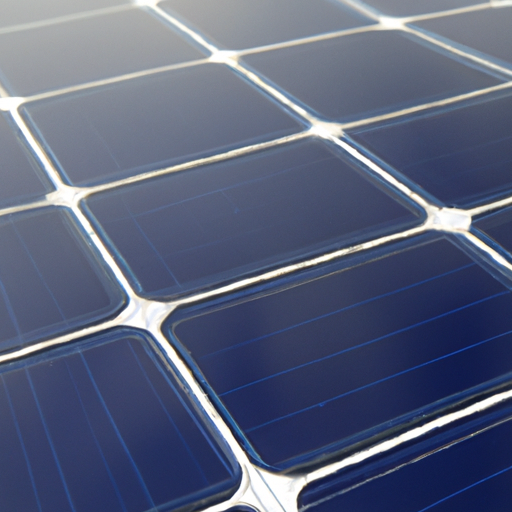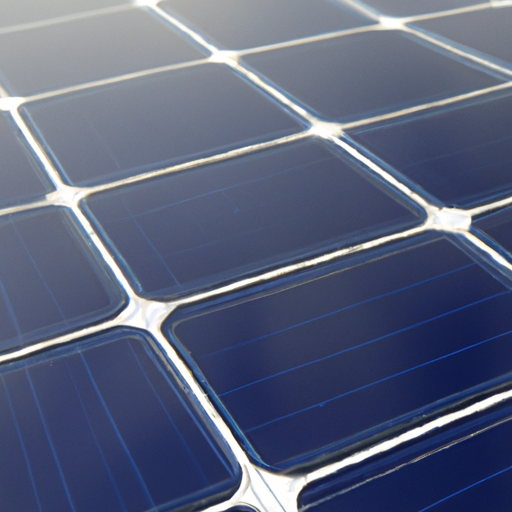

So, you’re curious about the difference between monocrystalline and polycrystalline solar panels when it comes to their efficiency and performance? Well, you’re in the right place! Whether you’re a solar power enthusiast, considering installing solar panels on your home, or just interested in renewable energy, understanding the variations between these two types is essential.
Monocrystalline solar panels are made from a single crystal structure, which gives them a uniform and smooth appearance. On the other hand, polycrystalline solar panels are made from multiple crystal structures, resulting in a more speckled or fragmented appearance. This difference in manufacturing technique ultimately has an impact on their efficiency and performance. In terms of efficiency, monocrystalline panels carry the edge. Their uniform structure allows for better absorption of sunlight, thereby generating more electricity per square meter compared to polycrystalline panels. However, it’s important to note that the actual efficiency of solar panels can be influenced by various factors, such as temperature, shading, and angle of installation. For a more in-depth look at the differences between these two types of solar panels and how they perform in various scenarios, keep reading our article!


Monocrystalline Solar Panels
Monocrystalline solar panels are a type of solar panel that is made from a single crystal structure. This means that the entire panel is made from a single, uniform crystal structure. The composition of monocrystalline solar panels typically consists of silicon, although other materials can be used as well.
Manufacturing Process
The manufacturing process of monocrystalline solar panels is complex and precise. It starts with the growth of a single crystal of silicon, which is then cut into thin wafers. These wafers are then treated to create a p-n junction, which is a key component of the solar panel. Finally, the wafers are connected to create the final monocrystalline solar panel.
Efficiency and Performance Comparison
Monocrystalline solar panels are known for their high efficiency and excellent performance. Due to the uniform crystal structure, monocrystalline panels are able to convert sunlight into electricity at a higher rate compared to other types of solar panels. They have a higher energy conversion efficiency, which means they can produce more electricity for the same amount of sunlight.
Advantages
There are several advantages of using monocrystalline solar panels. Firstly, their higher efficiency allows for greater electricity production, making them ideal for situations where space is limited. Additionally, monocrystalline panels are known for their longer lifespan compared to other types of solar panels. They are also more resistant to high temperatures and are less affected by shading.
Disadvantages
Despite their numerous advantages, monocrystalline solar panels also have some disadvantages. One of the main drawbacks is their higher cost compared to other types of solar panels. The complex manufacturing process and the use of high-quality materials contribute to their higher price tag. Additionally, monocrystalline panels are also more prone to damage from external factors such as extreme weather conditions.
Polycrystalline Solar Panels
Polycrystalline solar panels, on the other hand, are made from multiple crystal structures. The composition of polycrystalline solar panels also consists of silicon, but the crystal structures are less uniform compared to monocrystalline panels.
Manufacturing Process
The manufacturing process of polycrystalline solar panels is simpler compared to monocrystalline panels. It starts with the melting of raw silicon, which is then poured into a mold and cooled. This results in the formation of multiple crystal structures within the panel. The panels are then cut and processed to create the final polycrystalline solar panel.
Efficiency and Performance Comparison
Polycrystalline solar panels have a slightly lower efficiency compared to monocrystalline panels. The multiple crystal structures in polycrystalline panels result in a less uniform distribution of charge carriers, which affects the panel’s ability to convert sunlight into electricity. However, the difference in efficiency between the two types of panels is relatively small and may not be significant for many applications.
Advantages
Polycrystalline solar panels have some advantages that make them suitable for certain situations. One of the main advantages is their lower cost compared to monocrystalline panels. The simpler manufacturing process and the use of lower-quality materials contribute to their lower price. Additionally, polycrystalline panels also have a shorter payback period, making them a more cost-effective option for some users.
Disadvantages
Despite their lower cost, polycrystalline solar panels have some disadvantages as well. As mentioned earlier, their lower efficiency compared to monocrystalline panels means that they are not able to convert sunlight into electricity at the same rate. They also have a slightly shorter lifespan compared to monocrystalline panels. Additionally, polycrystalline panels are more susceptible to the effects of shading and high temperatures.
Efficiency
Efficiency in the context of solar panels refers to their ability to convert sunlight into electricity. The efficiency of a solar panel is measured as a percentage, with higher percentages indicating higher efficiency.
Definition
Efficiency can be defined as the ratio of the output power of a solar panel (electricity generated) to the input power (sunlight). It represents how effectively the panel can convert sunlight into usable electricity.
Factors Affecting Efficiency
Several factors can impact the efficiency of a solar panel. One of the main factors is the type of solar panel, as different types have different efficiencies. The temperature also plays a role in efficiency, as higher temperatures can reduce the panel’s ability to convert sunlight into electricity. The angle of the panels in relation to the sun and the amount of shading they experience can also affect efficiency.
Monocrystalline vs Polycrystalline Efficiency Comparison
In terms of efficiency, monocrystalline solar panels generally have a higher efficiency compared to polycrystalline panels. The uniform crystal structure in monocrystalline panels allows for a more efficient conversion of sunlight into electricity. However, the difference in efficiency between the two types of panels is not significant and may not be a determining factor for many users.


Performance
Performance in the context of solar panels refers to how well they generate electricity over time. The performance of a solar panel can be influenced by various factors.
Definition
Performance can be defined as the ability of a solar panel to consistently generate electricity over its lifetime. It takes into account the panel’s efficiency, durability, and the impact of external factors such as temperature and shading.
Factors Affecting Performance
Several factors can affect the performance of a solar panel. One of the main factors is the quality and construction of the panel itself. The materials used, the manufacturing process, and the design all play a role in determining the panel’s performance. External factors such as temperature, shading, and dust can also impact performance.
Monocrystalline vs Polycrystalline Performance Comparison
In terms of performance, both monocrystalline and polycrystalline solar panels can perform well under optimal conditions. However, monocrystalline panels are known for their higher performance due to their higher efficiency and longer lifespan. That being said, the difference in performance between the two types of panels may not be significant for many users.
Cost
The cost of solar panels is an important consideration for many potential buyers. Understanding the cost of monocrystalline and polycrystalline solar panels can help in making an informed decision.
Monocrystalline Solar Panels Cost
Monocrystalline solar panels are generally more expensive compared to other types of solar panels. The higher cost is due to the complex manufacturing process and the use of high-quality materials. However, the cost of monocrystalline panels has been decreasing over the years as technology advances and economies of scale are achieved.
Polycrystalline Solar Panels Cost
Polycrystalline solar panels are generally more affordable compared to monocrystalline panels. The simpler manufacturing process and the use of lower-quality materials contribute to their lower cost. This makes polycrystalline panels a more cost-effective option for those on a tighter budget.
Cost vs Efficiency Comparison
When considering the cost of solar panels, it is important to take into account their efficiency as well. While monocrystalline panels may be more expensive, their higher efficiency can result in greater electricity production over time. This means that despite the initial higher cost, monocrystalline panels may offer better value in the long run.
Durability
The durability of solar panels is an important factor to consider, as they are exposed to various environmental conditions over their lifetime. Understanding the durability of monocrystalline and polycrystalline solar panels can help in making an informed decision.
Monocrystalline Solar Panels Durability
Monocrystalline solar panels are known for their durability and long lifespan. The high-quality materials and the uniform crystal structure contribute to their ability to withstand various weather conditions. Additionally, monocrystalline panels are less affected by high temperatures and shading, further enhancing their durability.
Polycrystalline Solar Panels Durability
Polycrystalline solar panels are also durable, although they may have a slightly shorter lifespan compared to monocrystalline panels. The multiple crystal structures in polycrystalline panels make them slightly more vulnerable to external factors such as temperature and shading. However, with proper installation and maintenance, polycrystalline panels can still have a long and reliable lifespan.
Durability Comparison
In terms of durability, both monocrystalline and polycrystalline solar panels can withstand various environmental conditions. However, monocrystalline panels are often considered to be more durable due to their higher quality materials and the uniform crystal structure. That being said, the difference in durability between the two types of panels may not be significant for many users.
Environmental Impact
The environmental impact of solar panels is an important consideration, as their use promotes clean and renewable energy. Understanding the environmental impact of monocrystalline and polycrystalline solar panels can help in making an environmentally conscious choice.
Monocrystalline Solar Panels Environmental Impact
Monocrystalline solar panels have a relatively low environmental impact compared to other energy sources. The manufacturing process does require the use of energy and involves the emission of some greenhouse gases. However, the use of solar panels reduces reliance on fossil fuels, resulting in lower carbon emissions and a smaller environmental footprint.
Polycrystalline Solar Panels Environmental Impact
Polycrystalline solar panels also have a relatively low environmental impact. The manufacturing process of polycrystalline panels requires less energy compared to monocrystalline panels, resulting in lower greenhouse gas emissions. Additionally, the use of solar panels reduces the need for fossil fuels, which further contributes to a smaller environmental footprint.
Comparison
In terms of environmental impact, both monocrystalline and polycrystalline solar panels offer significant benefits compared to traditional energy sources. Both types of panels contribute to reducing carbon emissions and promoting clean energy. The slight difference in the manufacturing process and energy requirements may lead to a slightly lower environmental impact for polycrystalline panels, but the overall impact is relatively minor.
Applications
Solar panels are used in various applications to harness the power of the sun and convert it into usable electricity. Understanding the applications of monocrystalline and polycrystalline solar panels can help in choosing the most suitable option.
Monocrystalline Solar Panels Applications
Monocrystalline solar panels are commonly used in residential and commercial applications where space is limited. Their higher efficiency allows for greater electricity production in limited areas. Additionally, monocrystalline panels are also suitable for off-grid applications, such as powering remote cabins or RVs.
Polycrystalline Solar Panels Applications
Polycrystalline solar panels are also commonly used in residential and commercial applications. They are suitable for situations where cost is a significant factor, as they offer a more affordable option compared to monocrystalline panels. Polycrystalline panels can also be used for off-grid applications, although their efficiency may be slightly lower compared to monocrystalline panels.
Suitability Comparison
The suitability of monocrystalline or polycrystalline solar panels depends on the specific requirements of the application. Monocrystalline panels are suitable for situations where space is limited and higher efficiency is desired. Polycrystalline panels are suitable for situations where cost is a significant factor and slightly lower efficiency is acceptable. Both types of panels can be used for various residential, commercial, and off-grid applications.
Maintenance
Proper maintenance of solar panels is important to ensure their long-term performance and durability. Understanding the maintenance requirements of monocrystalline and polycrystalline solar panels can help in keeping them in optimal condition.
Monocrystalline Solar Panels Maintenance
The maintenance requirements of monocrystalline solar panels are relatively low. Regular cleaning of the panels to remove dust and debris is recommended to ensure optimal sunlight absorption. Additionally, it is important to regularly inspect the panels for any damage and to ensure that the electrical connections are secure. In case of any significant damage, professional assistance may be required.
Polycrystalline Solar Panels Maintenance
Polycrystalline solar panels have similar maintenance requirements to monocrystalline panels. Regular cleaning and inspection are recommended to keep the panels in optimal condition. Ensuring that the electrical connections are secure and there are no signs of significant damage is important for maintaining the performance and durability of polycrystalline panels.
Maintenance Comparison
In terms of maintenance, both monocrystalline and polycrystalline solar panels have similar requirements. Regular cleaning and inspection are important for both types of panels to ensure their optimal performance and longevity. The specific maintenance needs may vary depending on the installation and environmental conditions.
Conclusion
In conclusion, both monocrystalline and polycrystalline solar panels have their own advantages and disadvantages in terms of efficiency and performance. Monocrystalline panels are known for their higher efficiency and longer lifespan, but they come with a higher cost. Polycrystalline panels, on the other hand, offer a more affordable option with slightly lower efficiency. The suitability of each type of panel depends on the specific requirements of the application, such as space availability and budget constraints. Regardless of the type chosen, solar panels offer a clean and renewable energy solution that can significantly reduce carbon emissions and contribute to a more sustainable future.



